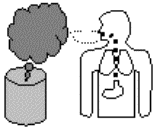Health Effects from Chemical Exposure
Hazardous Substances and Sites

Nearly every activity leaves behind some kind of waste in the environment. Households create ordinary garbage. Cars, trucks, and buses emit exhaust gases while in operation. Industrial and manufacturing processes create solid and hazardous waste. Some wastes contain chemicals that are hazardous to people and the environment. Once these hazardous chemicals are present in the environment, people can become exposed to them. Exposure occurs when people have contact with a chemical, either directly or through another substance contaminated with a chemical.
For more information on certain chemicals, such as the likely health effects, visit the Agency for Toxic Substances and Disease Registry's ToxFAQs website.

The place where the chemical originates is called the source. Chemicals can enter the environment from many different sources such as landfills, incinerators, tanks, drums, or factories. Human exposure to hazardous chemicals can occur at the source or the chemical could move to a place where people can come into contact with it. Chemicals can move through air, soil, and water. They can also be on plants or animals, and can get into the air we breathe, the food we eat and the water we drink.
The different ways a person can come into contact with hazardous chemicals are called exposure pathways. There are three basic exposure pathways: inhalation, ingestion, and skin contact. Inhalation is breathing or inhaling into the lungs. Ingestion is taking something in by mouth. Skin contact occurs when something comes in direct contact with the skin. Ingestion can be a secondary exposure pathway after skin contact has occurred, if you put your hands in your mouth and transfer the chemical from your hands to your mouth.

The Environmental Protection Agency (EPA) has developed informational summaries on selected chemicals to describe how people might be exposed to these chemicals and how exposure to them might affect their health. The summaries also explain what happens to the chemicals in the environment, who regulates them, and whom to contact for additional information.
Some common ways a person may be exposed to hazardous chemicals include:
Water. Exposure can occur when people drink contaminated groundwater or surface water, or accidentally ingest it while swimming or showering. Direct skin contact also is an exposure pathway that occurs during activities like swimming and showering. For more information about water and hazardous chemicals, view the MDNR, CDC and EPA websites.
Soil, Sediment, or Dust. People can be exposed to hazardous chemicals in soil, sediment, or dust if they accidentally ingest it, breathe it in, or have direct skin contact. Children are highly susceptible to these exposure pathways. In their daily activities, children have a tendency to have frequent hand-to-mouth contact and introduce non-food items into their mouths. For more information about hazardous substances, view the EPA webpages.
Air. Exposure can occur when people breathe in hazardous chemical vapors or air that is contaminated by hazardous chemicals or dust. More information is available about chemicals in the air at the websites of MDNR, CDC and EPA.
Food. People can be exposed to hazardous chemicals through the food they eat. Food contamination can occur if the food has come into contact with hazardous chemicals. It can also occur further down the food chain such as through eating contaminated fish. For more information, see the DHSS fish advisory.

Exposure, the chemical getting into or on your body, has to occur to make you sick or cause adverse health effects, or have any affect on your health. If you are not exposed to the chemical, it cannot make you sick. Also, even if exposure has occurred, adverse health effects may not occur.
Adverse health effects are dependent on the factors of the exposure. Factors that play a part in whether or not adverse health effects may result from an exposure are:
![]()
- the type of chemical;
- the amount or dose (the amount or level of a chemical a person was exposed to);
- the duration (how long did exposure occur); and
- the frequency (how many times the person was exposed).
![]()
Also, the occurrence of adverse health effects can depend on the way the chemical enters your body. Some chemicals rapidly absorb through skin, others not at all. Health effects also depend on the toxicity of the chemical that entered your body. Some chemicals are very toxic in small amounts; others are only toxic in large volumes.

Also, people respond to chemical exposure in different ways. Some people may be exposed to a chemical and not get sick. Other people may be more sensitive to chemicals and get sick more rapidly or have more severe reactions than others. Certain variables play a role in a person's susceptibility to exposure and adverse health effects such as age, gender, genetics, pregnancy or other health conditions.
For the fetus, child, and adolescent, the adverse health effects from exposure to chemicals can be much greater than for adults. The factors that affect their susceptibility include their stage of development and level of activity in the environment. The fetus is the most susceptible because their developing organs may be permanently damaged. Similarly, children, especially from one to six years of age, are also in a stage of rapid development. During this period, children may take more chemical into their bodies due to body chemistry, level of activity, and relative small body size. As children develop, chemicals introduced into the body can alter many processes essential for proper cell development. As a result, changes can, for example, cause organs within the body to be altered, impairing proper development to a mature organ. Adolescents may share in the risk due to their increased physical activity and curiosity of the world around them. For more information, see Children's Health Protection.
The human body has the ability to tolerate certain amounts of chemicals and the ability to excrete chemicals from the body. Once a person is exposed to a chemical, it may enter the blood stream, and eventually reach the liver. The liver attempts to detoxify harmful chemicals in the body by converting them to less toxic ones or ones that could be used by the body. The body naturally attempts to eliminate substances that are harmful or are not used. The kidneys filter substances out of the blood and excrete them in urine. Also, chemicals are removed from the body in feces, sweat and exhalation. However, the body may not be able to remove all the chemicals. The amount, type, and length of time you are exposed to harmful substances will determine if you are at risk for adverse health effects.
Therefore, the state and federal governments have determined health-based comparison values for contaminants that when exceeded, exposure may result in an excessive health risk. The chart below contains levels used by agencies to determine if doses of chemicals may be harmful to human health.
| Government Agency Who Established |
Name |
Type of Limit |
Description |
|---|---|---|---|
EPA |
Maximum Contaminant Levels (MCLs) |
Legally Enforceable Limits |
The highest level of a contaminant that is allowed in public drinking water. These are federally enforceable standards. |
EPA |
Maximum Contaminant Level Goals (MCLGs) |
Advisory Levels |
The level of a contaminant in drinking water below which there is no known or expected risk to health. MCLGs allow for a margin of safety and are non-enforceable public health goals. |
EPA |
National Ambient Air Quality Standards (NAAQS) |
Legally Enforceable Limits |
Standards for maximum levels of contaminants for ambient air. |
ATSDR |
Minimal Risk Levels (MRLs) |
Advisory Levels |
Used to evaluate short and long-term exposure to a variety of chemicals. |
MDNR |
Missouri Risk-Based Corrective Action Guidance (MRBCA) DRAFT |
DRAFT Legally Enforceable Limits |
Health-based screening values for contaminants in soil and water. This document is being developed and is in draft form. |
